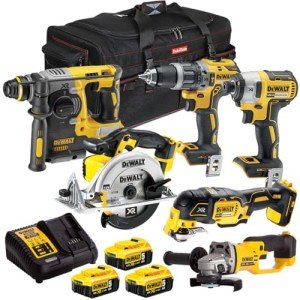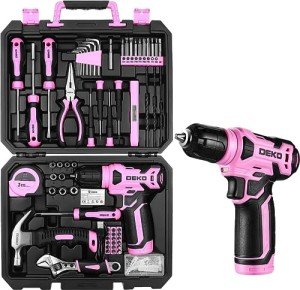
Power Tool Kit
Add a review FollowOverview
-
Founded Date July 1, 1967
-
Posted Jobs 0
-
Viewed 4
Company Description
Nine Things That Your Parent Teach You About Battery Powered Tool Set

Comprehensive Guide to Battery-Powered Tool Sets
In the last few years, battery-powered tools have transformed the way both specialists and DIY lovers approach their tasks. With their benefit and performance, battery-powered tool sets have ended up being a staple in workshops nationwide. This blog site post explores the advantages of battery-powered tools, important components, comparisons, and answers to some often asked questions.
Why Choose Battery-Powered Tool Sets?
Battery-powered tools offer many benefits over their corded counterparts:
-
Portability: Without the barrier of a cable, battery-powered tools can be quickly carried and used anywhere.
-
Convenience: Quick setups remove the requirement for outlet access, making them perfect for outdoor tasks.
-
Decreased Trip Hazards: The lack of cables enables a more secure office, especially in congested or messy environments.
-
Technological Advancements: Most contemporary battery-powered tools feature powerful lithium-ion batteries that provide longer runtimes and faster charging times.
Secret Components of a Battery-Powered Tool Set
A typical battery-powered tool set may include different tools tailored to meet the needs of various projects. Below is an extensive table showcasing requirement tools discovered in these sets:
| Tool | Purpose | Typical Battery Voltage | Common Brands |
|---|---|---|---|
| Drill/Driver | For drilling holes and driving screws | 12V to 20V | DEWALT, Makita, Milwaukee |
| Circular Saw | For cutting wood, plywood, and other materials | 18V to 20V | Bosch, Ryobi, Black+Decker |
| Reciprocating Saw | For demolition and rough cuts in various products | 18V | Porter-Cable, Hitachi |
| Impact Driver | For driving big screws/fasteners | 12V to 20V | Craftsman, Ridgid |
| Sander | For smoothing surfaces and ending up wood | 12V to 20V | Ryobi, Milwaukee |
| Angle Grinder | For cutting and grinding metal, masonry, and tiles | 18V | Makita, DEWALT |
| Jigsaw | For detailed cuts in wood, plastic, and metal | 12V to 20V | Black+Decker, Bosch |
Notable Features to Consider
When picking a battery-powered Tool Bundles set, a number of functions can boost functionality and performance:
-
Battery Life: Look for tools with lithium-ion batteries that offer longer runtimes and charge quickly.
-
Interchangeability: Some tool sets permit for battery compatibility throughout multiple tools, reducing the need for multiple batteries.
-
Weight: Consider the ergonomics; lighter tools can minimize fatigue throughout comprehensive use.
-
Sturdiness: Robust construction and protective functions (like dust and water resistance) guarantee the durability of the tools.
-
Service warranty and Support: Good brand names generally use service warranties that cover defects and provide consumer assistance for queries.
Comparing Battery-Powered Tools to Corded Tools
The choice between battery-powered and corded tools often boils down to personal preference and job requirements. Here’s a comparison:
| Feature | Battery-Powered Tools | Corded Tools |
|---|---|---|
| Mobility | High – can be used anywhere | Restricted – requires distance to Power Tool Sets UK outlets |
| Runtime | Restricted by battery life | Constant as long as plugged in |
| Power Tool Combo Sets Output | Usually less powerful than corded | Often more powerful |
| Upkeep | Requires battery powered tool set care | Lower upkeep; more uncomplicated |
| Cost | Usually greater initial financial investment | More affordable for individual tools |
| Flexibility | Many multi-purpose tools offered | Specialized tools offered |
Best Practices for Using Battery-Powered Tool Sets
To make the most out of a battery-powered tool set, follow these best practices:
-
Charge Batteries Regularly: To guarantee maximum battery life, avoid deep discharging and charge batteries after each use.
-
Tidy Tools After Use: Keeping your tools tidy minimizes wear and tear and can help protect their lifespan.
-
Store Safely: Keep Electric Tools Kit in a dry, safe and secure place to prevent damage and guarantee simple gain access to.
-
Check Out User Manuals: Each tool might have specific operating guidelines or maintenance suggestions; checking out the handbook can conserve time and disappointment.
Frequently Asked Questions (FAQs)
1. For how long do battery-powered tools last?
The lifespan of battery-powered tools depends on use and upkeep however can last several years with correct care. Lithium-ion batteries usually last 2-3 years, depending on charging practices.
2. Can I utilize my battery-powered tools in winter?
Severe cold can affect battery efficiency. It’s best to keep batteries at room temperature when not in usage and enable them to heat up before usage in cold conditions.
3. Are all battery-powered tools suitable with the very same battery?
Not always. Battery compatibility typically depends on the brand and particular tool design. It’s vital to verify compatibility before purchasing additional tools.
4. How do I keep lithium-ion batteries?
To maintain lithium-ion batteries, prevent complete discharges, keep them cool, and charge them after usage. It’s also advised to utilize the manufacturer’s battery charger.
5. What are the most necessary tools for a beginner?
For newbies, a drill/driver, circular saw, and impact motorist are typically the most necessary tools to start with, as they cover a vast array of fundamental tasks.
Battery-powered tool sets have actually changed how we approach traditional jobs, supplying a mix of convenience and performance. Whether for expert trades or DIY home improvements, these tools deal with diverse task requirements. By understanding the features, parts, and best practices related to battery-powered tools, users can enhance their efficiency and productivity. Equipped with this detailed guide, both newbies and experienced specialists can now make notified decisions when selecting their next tool set.

